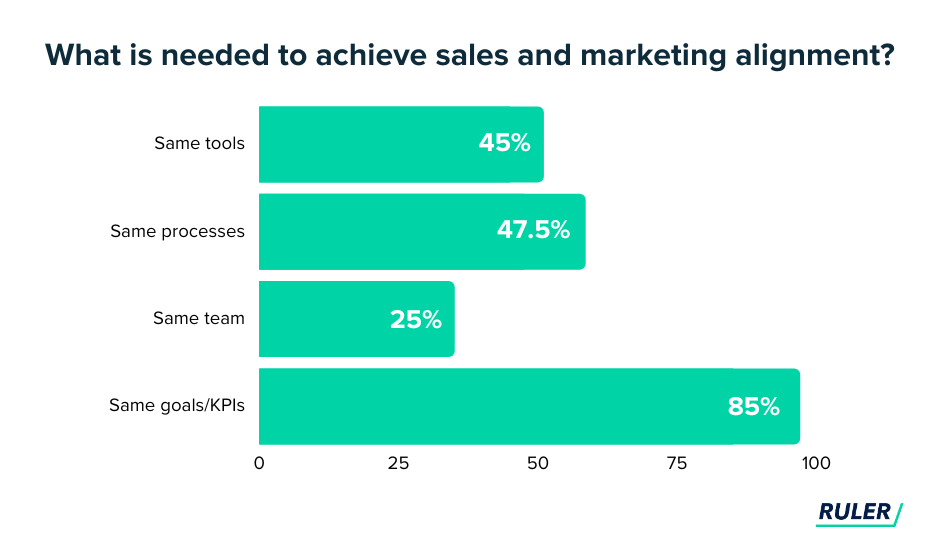Sales and marketing alignment is key for businesses, driving better results through effective collaboration. We share all you need to know on what it is and how you too can achieve smarketing.
Aligning your sales and marketing team takes time and a lot of patience. But done right, you can reap the rewards. According to Linkedin, 87% of sales and marketing leaders say collaboration between sales and marketing enables critical business growth.
So how do you make smarketing a thing? In this guide, we’re going to tell you exactly how to achieve – and maintain – sales and marketing alignment in your business.
In this guide we’ll be discussing:
💡 TL;DR
– Sales and marketing alignment aims to improve communication, transparency, and collaboration between teams to boost efficiency.
– When sales and marketing are working together harmoniously, you benefit from fewer unqualified leads, better closing rates and faster revenue growth.
– Sales and marketing incentives can misalign teams. Sales seek high-quality leads for commission, while marketers aim for quantity to meet their goals.
– Start with a CRM solution to align sales and marketing to provide a central customer database for seamless communication. It also helps to integrate your sales and marketing software, such as your marketing analytics and ad platforms, to give you a holistic view of the customer journey.
– Align sales and marketing around a common revenue goal to drive collaboration and ownership. Revenue will become your North Star to guide every marketing campaign and sales effort.
– Appointing leaders who understand the importance of collaboration can inspire their teams to work together towards common goals.
– To foster a culture of continuous improvement, it’s crucial to keep the feedback loop open. And, in the realm of sales and marketing, aligning incentives and recognition programs can be a game-changer.
Sales and marketing alignment, also known as smarketing, is the goal of enabling your sales and marketing teams to work with better communication, transparency and collaboration in order to achieve greater efficiency.
The ultimate end goal of smarketing is to get higher quality leads to enable high-profit sales at an increased rate. Basically, more revenue.
Historically, sales and marketing teams have worked in a silo and developed independently. This means teams sit in different offices, use different technologies and have different goals.

The aim of sales and marketing alignment is to break down these barriers. According to MarketingProfs, sales and marketing alignment can result in 38% higher sales win rates.
When sales and marketing are working together harmoniously, you can achieve three significant benefits:
Less unqualified leads: When sales and marketing work in tandem, the result is a more refined lead generation process. Marketing can better tailor their efforts to attract the right audience, ensuring that sales reps are not bogged down with uninterested or unqualified leads.
More efficient deal closings. A seamless handover of leads from marketing to sales means fewer lost opportunities and a fuller pipeline.
Faster revenue growth: Ultimately, the alignment of sales and marketing accelerates your path to revenue growth. With better lead quality, faster deal closures, and more efficient processes, your company can quickly expand its customer base and, subsequently, boost its revenue.
If you’re not sure sales and marketing alignment is for you, then there are some key statistics to take note of:
Communication in business is hard. Many companies hire internal communication professionals to manage the task properly. And with sales and marketing sitting separately, it’s no surprise that communication between teams is hard.
Sales are often incentivised by commission. It’s how they make their salary. So they want leads that are going to turn into revenue. And when a marketer passes over a boatload of leads they’ve had no view of, you can understand why getting their buy-in to pursue them can be hard.
Marketers meanwhile, just want to tick their goal of driving leads. They can’t view the lead quality, so instead they throw money and time into lead generation tactics that might not necessarily be driving future revenue.
So you can see where the disconnect is. But how can you align your two teams?
Well, we have some tips and tricks that we’ve used internally, and seen used across other businesses, we thought we would share.
To gather the best practices and tools needed to align marketing and sales, we asked dozens of experts to weigh in and share their input. Here’s what they said:
The best way to align sales and marketing is to have them striving for the same overall goal. We found that 85% of businesses believe having the same goals and KPIs allows you to achieve sales and marketing alignment.

Of course, they might have different personal KPIs or team KPIs, but ultimately they should all work together to drive new customers, not new leads.
Ian Sells, CEO and co-founder of RebateKey said, “To best align your marketing and sales, it is necessary to create the same KPIs and goals.
“Having shared goals allows both teams to work and strategise together, providing a more holistic approach towards marketing. This ensures that the transition from marketing to sales is seamless, preventing mismatched messages from one part of the funnel to another (causing customer confusion and losing their trust).”
Related: KPIs to align your sales and marketing teams
Susan Thompson, Digital Marketing Manager at Topp Casino Bonus agreed, adding, “Historically, sales and marketing function with different key performance indicators (KPIs) and, therefore, different goals. Most goals are separate — Sales may be focused on monthly revenue while Marketing hones in on website traffic.
“A good marketing strategy prioritises shared goals, too. There are a few KPIs — like conversion rate and lead value — that both teams can measure and influence. Identify these KPIs for your sales and marketing teams can work towards.”
Aligning sales and marketing around a common revenue goal drives collaboration and ownership. Revenue becomes the North Star that guides every marketing campaign and sales effort.
Strong leadership is key to driving alignment between sales and marketing.
Appoint leaders who understand the importance of collaboration and can inspire their teams to work together towards common goals. Leadership sets the tone for the entire organisation.
Matt Lally, Founder at TheGiftYak agreed, “Leadership is what aligns sales and marketing. Without it, no tool or KPI can save the program.”
While some of the existing team might be more difficult to convert, having a really strong onboarding process for new recruits means more advocates for you to get it to work.
The foundation of successful sales and marketing alignment starts with selecting the right software.
45% of marketers and sales professionals agreed that having the same tools helps you achieve sales and marketing alignment.
Before anything else, get a CRM solution if you don’t already have one. A central customer information database is essential for seamless communication across your company.
It also helps to integrate your sales and marketing software, such as your analytics and ad platforms. This will give you a holistic view of the customer journey and help you make better, collaborative decisions about where to allocate your resources.
Joshua Wood, CEO at Bloc agreed, “Choose your software wisely and keep things as simple as possible. Companies that over complicate the processes and set up won’t ever achieve true alignment.”
💡 We advise investing in an attribution tool that integrates with your CRM to enrich leads with marketing touchpoint data, revealing your most valuable lead sources. This will put an end to the guessing game of where your most valuable leads are coming from. 13 marketing attribution tools and software.
Collaboration should extend beyond meetings.
Encourage your sales and marketing teams to work together to define what constitutes a quality lead. This shared definition ensures that marketing efforts are more likely to result in leads that the sales team can effectively convert.
Noelle Fauver, Director of Inseev Interactive, agreed, “Make sure sales and marketing teams align on what the ideal client looks like and ensure that the marketing team is executing on campaigns that will meet these parameters.
Regularly assess your sales team close rates and determine what is preventing a higher close rate, make implementations across both sales and marketing teams to combat this.”
“Everything sales hears should feed a marketing strategy. On the flip side, marketing needs to ensure that sales is using the defined brand tone/messaging from the top of the funnel in their prospecting efforts,” says Rich Pusateri, Content Marketing Manager at Postal.
To foster a culture of continuous improvement, it’s crucial to keep the feedback loop open. You should have a presence at regular meetings and check-in with one another.
“Make this a weekly and monthly habit to track your sales and marketing numbers. This way you can see if it’s out of alignment or aligned, and make adjustments,” Brian Robben, President at Robben Media LLC.
Understanding your sales team and their current problems will allow you to identify possible solutions from the marketing team. Perhaps they’re wasting a lot of time with manual emails that you could take over with automation?
Or maybe they want to hit a big list of old leads but don’t know where to start? Your marketing team could help create a segmented email cadence to drive warmer leads for sales to pick up.
Sales should provide feedback on the quality of leads and the effectiveness of marketing materials, and marketing should reciprocate with insights on how leads respond to different content and campaigns.
Zack Flathmann, Marketing Director at TacMed Solutions agreed adding, “The sales and marketing teams need to be driving toward the same goal with the same coordinated messaging. For us, it’s important that sales is always aware of what our marketing communications plan is for the month, quarter and year.”
You hire your sales team for a reason. You want them to get to know your customers and sell your product to them. Use that insight.
While your marketing team will understand a lot of the issues your potential customer has, nobody knows them better than sales.
Alex Williams, Sales & Marketing Coordinator at Find this Best agreed, adding, “One of the best ways to align your sales and marketing team is to analyse your customer feedback. I would advise you to gather this data through customer service calls to ensure customers’ demand and then offer products and services.
“When you cater to the needs of your customers, your sales automatically increase. Not only does customer feedback help you provide better products, but it improves your marketing as well.
“With effective feedback, you can make promotional campaigns that will boost sales effectiveness and revenue. Lastly, these findings can subsequently be used to select specific phrases for future marketing messages.”
For each stage of the buyer’s journey, you want to be hitting your potential customers with relevant content. Without clear communication, your marketing team might be spending a lot of time writing SEO blogs, but not enough time writing strong case studies.
By speaking to your sales team and devising content across the entire customer journey, you’re missing out potential opportunities for new content.
And don’t forget the sales collateral! You can’t have really strong web content to pull a lead in and then try to win them over with a sales deck you’ve had lying around for years.
Pull your marketing and sales team together to create strong sales collateral that can be used to convert leads.
Attila Colaci, Performance Marketing Manager at Hatchhouse added, “Start by looking into the consumer’s behaviour flow, starting from awareness to returning customers and mapping out processes for each core audience your business targets. With the general customer process mapped out, you can easily see where your marketing touchpoints are, and where customer support and customer retention activities need to be.
“Based on this, you can set KPIs for each team making sure everyone is working together towards the same goal: growing your business. However, to ensure that you have a clear overview of the value of each touchpoint and value of each client, you will need clear processes across your team, and a marketing attribution tool that ties all the data together.”
Jack Zmudzinski, Senior Marketing Specialist at StartNearshoring agreed, “A great place to start is the customer journey. Brainstorming together with your sales and marketing team makes for an amazing opportunity to align your goals, metrics and all of the stages of the funnel.
Each stage should be intertwined with one another, as discussed with both departments, to provide the best, seamless experience for the entire journey. The best way to do that is by using CRM software. You get to keep all data in one place and share it with all team members.”
Motivation is the fuel that powers your teams to perform at their best. In the realm of sales and marketing, aligning incentives and recognition programs can be a game-changer.
When individuals from both teams are incentivised to support each other’s efforts, collaboration and alignment naturally follow. Consider setting up joint performance rewards or recognition programs to foster teamwork.
Perry Zheng, CEO at Cash Flow Portal suggested motivating your teams. “To achieve sales and marketing alignment, you have to start by motivating everyone on your team – from the CEO to the most junior sales rep – to better understand the financial value of the work they do.
“Then, you have to clearly define how each role contributes toward achieving a company’s financial goals. The important thing in alignment is not to think in terms of tactical initiatives, but to anticipate the broad trends in your industry and how your business strategy can capitalise upon these.”
And there you have it, some simple ideas to help align your sales and marketing teams.
Remember, the key is implementing the same tools and processes and aligning your goals.
As we know, marketing struggles to report on revenue while sales specifically report on revenue.
But revenue attribution is a valuable solution. When marketing teams are dealing with leads being picked up by the sales team, there is a huge amount of data being lost on both sides.
Marketing can’t see where the lead has come from or how it progresses. Sales can’t see where the lead came from or provide further feedback on trends surrounding high and low-quality leads.
By implementing marketing attribution, you can close the data disconnect and give the right data, to the right people, in all of the right places.
Ruler supports marketers (and sales representatives) to better understand their leads and drive more, high-quality leads using data-driven insights. Find out how you can begin the process of aligning your sales and marketing through attribution by booking a demo with one of our very own sales reps!
